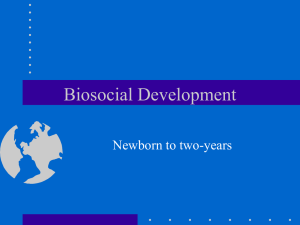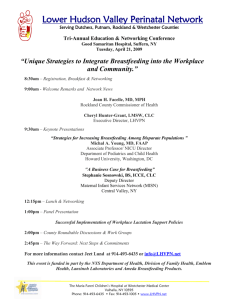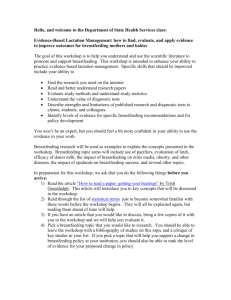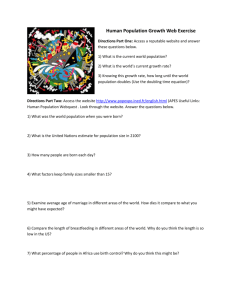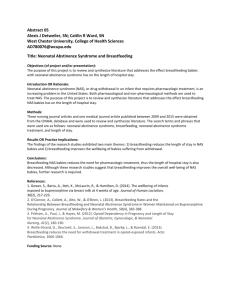opiates & breastfeeding
advertisement
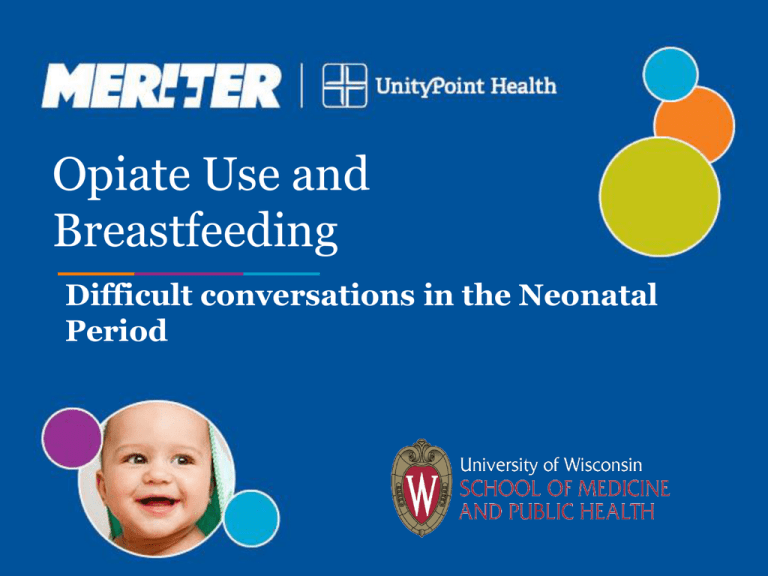
Opiate Use and Breastfeeding Difficult conversations in the Neonatal Period Disclosures • I have nothing to disclose and no conflicts of interest 2 A Common Scenario….. • You are called to do a prenatal consult with a pregnant mom • Mom is on methadone maintenance for a previous heroin addiction • You meet a well dressed young woman who is obviously nervous about this discussion • Her main question: Can I breastfeed? 3 Objectives • Provide an update on the prevalence and patterns of opiate use in breastfeeding women • Describe the passage of opiate medications into breast milk and the effects on the newborn • Discuss indications and contraindications to breastfeeding in women using opiates Illicit Substance Use • 10.2% of Americans older than 12 are current illicit drug users • Non-medical use of prescription drugs is second only to Marijuana use Past Year Heroin Initiates among People Aged 12 or Older, by Age Group (in thousands): 2002-2014 (SAMSHA NSDUH 2014) – Primarily opioid class pain relievers • Use of Heroin has more than doubled since 2007 SAMSHA NSDUH 2014 5 Scope of the Problem: • Among pregnant women: – 5.9% report use of illicit drugs (Samsa-NSHUD 2013) – 28% were prescribed at least one opioid pain reliever during pregnancy (Patrick 2015) • 96% were non-maintenance prescription opioids – 20% of women experience mood or anxiety disorders during pregnancy (Flynn 2006) Substance Use Patterns Prepared 3/3/2015 by Karina Atwell, MD UW‐Madison Preventive Medicine Resident 7 Opioids in Pregnancy • Opioids easily pass the placental and blood-brain barrier. • Fetus can develop physical addiction – Opioids inhibit release of norepinephrine from nerves in the brain – Tolerance develops and more norepinephrine is produced by the brain to overcome the inhibition – If opioids are suddenly taken away large amounts of norepinephrine are released and produce the physical signs of withdrawal • If the mother stops using opioids her fetus will experience withdrawal and will be at increased risk for distress and fetal loss Neonatal Abstinence Syndrome (NAS) 9 Incidence of neonatal abstinence syndrome per 1000 hospital births in the United States, 2009 to 2012. Patrick, J Perinatol 2015 10 NAS in Wisconsin Prepared 3/3/2015 by Karina Atwell, MD UW‐Madison Preventive Medicine Resident 11 Treatment of NAS • Pharmacologic treatment with opiates – Restart the infant on morphine – Slowly wean • Non-pharmacologic treatment – – – – – Tight swaddling Holding and rocking Quiet dark room Limit number of visitors Feeding on demand • Small frequent feeds – Have pacifier available Length of Stay Prepared 3/3/2015 by Karina Atwell, MD UW‐Madison Preventive Medicine Resident 13 How do opiates work? 14 Passage of opiates into milk 15 What is baby getting? • Depends on – Size of molecule – Degree of protein binding – Lipid solubility – Ionization – Maternal factors – Infant factors 16 Estimating Infant Dose • Milk to Plasma Ratio – Ratio between the concentration of medication in the maternal plasma and milk at steady state – Estimate of the relative amount of drug in milk • Of limited value unless you know the maternal serum concentration – even if a medication has a milk to plasma ratio of greater than 1, the concentration in the breast milk may still be low if maternal plasma levels are low 17 Methadone • Full opioid agonist – Will interact with the brain in the same way that morphine does. • Very long half life (mean half life is 22 hours) • Mothers must go to the methadone clinic every day to get their dose Transfer of Methadone into Breastmilk • Variable but minimal transfer of methadone into breastmilk – Average amount transferred to infant 0.050.19 mg/day • 1-3% of maternal weight adjusted dose • Less than dosage used to treat NAS 19 Buprenorphine • Subutex/Suboxone • Semi-synthetic partial agonist – Binds opioid receptors in the brain but is not very active. • Can be prescribed to women who can pick up weeks worth of doses at one time • Popular choice for women in rural or remote areas. Buprenorphine and breastfeeding • Buprenorphine has low oral bioavailability (31%) • Very low levels in breastmilk – 0.38% of maternal buprenorphine dose – 0.18% of maternal norbuprenorphine dose • Assumed to be safe – more studies needed Ilett et al. Breastfeed Med 2012 21 Other Opiates • Hydrocodone, oxycodone and fentanyl – Usual doses for pain relief have minimal to no effect on infant – When used as a drug of abuse mothers should be transitioned to maintenance opiate – Caution with codeine 22 Polydrug Exposure • NAS complicated by the interplay between opioid withdrawal and withdrawal from other substances – SSRIs (7-8%) and Tobacco (85%) are common co-exposures – Symptoms are similar to NAS and may exacerbate NAS – Benzodiazepines, barbiturates and alcohol are also known to cause withdrawal signs in infants. Polydrug Exposure • Fetuses exposed to methadone + polysubstances in utero had: – Decreased fetal heart rate – Decreased fetal movement – Delivered 1 week earlier than fetuses exposed to methadone only or no methadone – Required treatment for NAS twice as often Jannson, Drug and Alcohol Dependence 2012 24 Breastfeeding and opiates 25 Breastfeeding and NAS • Challenges – Polydrug use – Infectious disease risk – Poor nutrition – Comorbid psychiatric disorders • Lack of evidence based guidelines Jansson. Breastfeeding Medicine 2009 26 Evidence Based Web Sites • LactMed – http://toxnet.nlm.nih.gov/newtoxnet/lactmed.ht m • E-Lactancia – http://e-lactancia.org – English and spanish 27 Screening for opiate use • Based on risk? • Universal screening? – Universal Drug Testing in a High-Prevalence Region for Opiate Abuse • 2995 pregnant women, 96 + for opiates • 77/96 had risk factors that would have triggered screening • 19/96 had no risk factors that would have triggered screen Wexelblatt et al. Journal of Pediatrics 2015 28 Breastfeeding Initiation Rates • UK – 14% in women using opiates vs 50% in general population (Goel 2011) • Norway – 77% in women using opiates vs 98% in general population (Welle-Strand 2013) • US - 187 women using opiate with no contraindications to breastfeeding – 66% did not initiate BF – 24% did initiate BF: 40% still BF at time of discharge (Wachman 2010) 29 Barriers to Breastfeeding • Low SES • High prevalence of mental health issues • Lack of knowledge about specific benefits of breastfeeding • Prejudice • Need for urine drug screening 30 Advantages of breastfeeding • Breastfeeding is recommended for women compliant with treatment and on maintenance medications regardless of dose – Shorter length of hospital stay – Lower Finnegan scores – Less likely to require pharmacologic treatment – If treatment is needed: lower doses of medication and shorter duration of treatment Abdel-Letiff, Pediatrics 2006 31 Breastfeeding and Incidence of NAS Requiring Pharmacologic Treatment Breastfed Formula Fed Welle-Strand 57% (n=58) 69% (n=20) Wachman 50% (n=38) 77% (n=48) Abdel-Latif 52.9% (n=85) 79% (n=105) O’Connor 23.1% 30% 32 Breastfeeding and Length of Treatment Breastfeeding Formula Feeding Abdel Latif 85 days (n=85) 108 days (n=105) Welle-Strand 31 days (n=58) 49 days (n=20) Wachman 15.8 days (n=38) 27.4 days (n=48) 33 Why? • Dosage of opioids in breastmilk low • Known benefits of breastfeeding: – Skin to skin – Holding and soothing – Bonding – Enhanced confidence – Increased maternal participation in care of the infant 34 Breastfeeding and SIDS • Protective effect of Breastfeeding against SIDS (AAP 2005) • Infants exposed to opiates at higher risk for SIDS (Burns et al 2010) 35 Encourage breastfeeding • • • • • • Women in treatment Consent for communication No illicit substance use in last 90 days Negative urine tox screens Consistent prenatal care No medical contraindications Reece-Stremtan Breastfeeding Medicine 2015 36 Consider breastfeeding • Relapse in 90-30 days before delivery but not within 30 days of delivery • Other prescription medications • Prenatal care or substance abuse treatment after the second trimester • Custody or sobriety as motivators • Lack of family and community support systems Reece-Stremtan Breastfeeding Medicine 2015 37 Counsel women not to breastfeed: • Not in substance abuse treatment • No prenatal care • Relapse into illicit substance use within 30 days of delivery • Unwillingness to seek treatment or allow communication • Positive urine tox screen at delivery • Women with active drug use • Chronic alcohol use • Other contraindication for breastfeeding Reece-Stremtan Breastfeeding Medicine 2015 38 No easy answers….. • Trauma informed care • Family centered care of the newborn • Prenatal counseling and education 39 References • CDC. Vital Signs: Overdoses of Prescription Opioid Pain Relievers and Other Drugs Among Women — United States, 1999–2010. Morbidity & Mortality Weekly Report. 2013, July 5:62(26);537-542 • Chisholm MS et al. Relationship between cigarette use and mood/anxiety disorders among pregnant and methadone maintained patients. Am J of Addiction. 2009;18:422-429 • Finnegan LP et al. Neonatal Abstinence Syndrome: Assessment and Management. Addictive Diseases. 1975;2(1):141158 • Flynn HA, Blow FC, Marcus SM. Rates and predictors of depression treatment among pregnant women in hospitalaffiliated obstetrics practices. General Hospital Psychiatry, Vol, 28, No. 4, July-August 2006, pp 289-29. • Hudak ML et al. Neonatal Drug Withdrawal. Pediatrics. 2012;129(2):e540-e561 • Jansson LM et al. The opioid exposed newborn: Assessment and pharmacologic management. Journal of Opioid Management. 2009;5(1):47-55 • Johnston A. Neonatal Abstinence Syndrome Scoring: Guidelines for treatment with methadone. Scoring Tool Training MOTHER study 2006 • Jones HE et al. Neonatal Abstinence Syndrome after methadone or buprenorphine exposure. NEJM. 2010;363(24):2320-2331 • King JC. Substance Abuse in Pregnancy. A bigger problem than you think. Postgrad Medicine. 1997;102(3):149-150 • Lambers DS and Clark KE. The maternal and fetal physiologic effects of nicotine. Semin Perinatol. 1996;20(2):115-26 • Patrick SW et al. Prescription Opioid Epidemic and Infant Outcomes. Pediatrics 2015 135(5) • Patrick SW et al. Incidence and Geographic distribution of NAS: United States 2009 to 2012. J Perinatol 2015 • Substance Abuse and Mental Health Services Administration. Results from the 2009 National Survey on Drug Use and Health: Vol 1: Summary of National Findings 2010 References • • • • • • • • • • Reese-Stremtan S. ABM Clinical Protocol #21: Guidelines for Breastfeeding and Substance Abuse or Substance Use Disorder, Revised 2015 Breastfeeding Medicine 2015: 10(3) Welle-Strand GK, Skurtveit S, Jansson LM, et al. Breast- feeding reduces the need for withdrawal treatment in opioid- exposed infants. Acta Paediatr 2013;102:1060–1066. Abdel-Latif ME, Pinner J, Clews S, et al. Effects of breast milk on the severity and outcome of NAS among infants of drug-dependent mothers. Pediatrics 2006;117:1163–1169. Jansson LM, Choo R, Velez ML, et al. Methadone main- tenance and breastfeeding in the neonatal period. Pediatrics 2008;121:106–114. Jansson LM, Choo R, Velez ML, et al. Methadone main- tenance and long-term lactation. Breastfeed Med 2008;3: 34–37. Kocherlakota P. Neonatal abstinence syndrome. Pediatrics 2014;134:e547–e561. Wachman EM, Byun J, Philipp BL. Breastfeeding rates among mothers of infants with neonatal abstinence syndrome. Breastfeed Med 2010;5:159–164. D’Apolito K. Breastfeeding and substance abuse. Obstet Clin Gynecol 2013;56:202–211. Jannson et al. Pregnancies exposed to methadone, methadone and other illicit substances, and poly-drugs without methadone: A comparison of fetal neurobehaviors and infant outcomes. Drug and Alcohol Dependence 2012 122(3): 213-219 41 Questions Elizabeth Goetz MD MPH Department of Pediatrics University of Wisconsin – Madison Meriter Hospital
